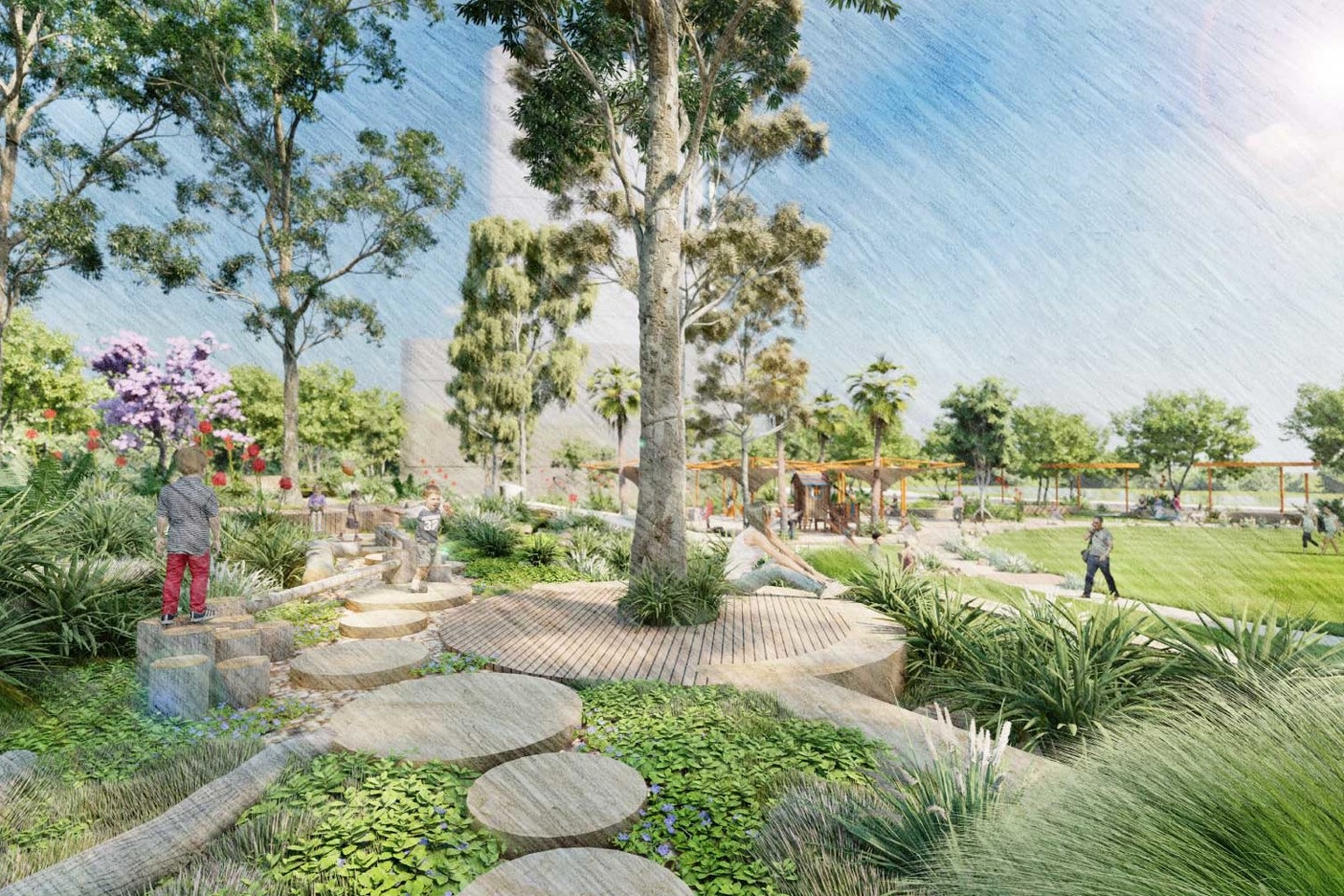Unveiling the Process: From Concept to Creation
Sketching Dreams: The Initial Design Phase
The initial phase of 3D landscape architecture is akin to laying the foundation of a grand edifice; it begins with conceptual sketches that capture the designer’s vision. Artists, architects, and landscape designers engage in brainstorming sessions, where ideas spring forth from the imagination into tangible concepts. During this stage, one might utilize diverse inspiration sources such as natural landscapes, urban designs, and cultural symbols. Rough sketches are often accompanied by mood boardsa collage of textures, materials, colors, and photographs that communicate the intended atmosphere of the project.
Iterations play a crucial role in refining the design. Feedback from clients, community stakeholders, and engineers is integral to this process. It is here that dreams transition into a structured design narrative, where considerations like local ecology, site constraints, and human experience are factored in. Artists explore theoretical perspectives around site usage and aesthetic allure, gradually developing detailed representations that will later be modeled in 3D software. This initial design phase not only sets the aesthetic direction but also establishes a strong engagement framework with the environments being depictedinviting nature, architecture, and community to coalesce in harmony.
Digital Tools and Technologies Revolutionizing Landscape Architecture
The advent of advanced digital tools has significantly transformed the landscape architecture profession. Software such as AutoCAD, SketchUp, and GIS (Geographical Information Systems) applications have streamlined the modeling and planning processes, enabling landscape architects to visualize their designs with unprecedented accuracy and depth. 3D modeling software allows for the manipulation of spatial elementsterrain, vegetation, and water featureson a virtual canvas, providing a clear representation of how these elements interact within the physical space. The use of Building Information Modeling (BIM) further enhances this practice, allowing for multi-dimensional data to be integrated, thereby facilitating collaboration across disciplines.
In addition to these traditional design tools, emerging technologies like parametric design and generative design algorithms have propelled the field into the realm of artificial intelligence. Parametric design allows architects to create responsive models that adjust to varying inputs, enabling designs that maximize functionality while adhering to aesthetic principles. Generative design algorithms assess multiple variables and propose numerous design iterations, optimizing various parameters such as cost, sustainability, and materials usage. These sophisticated technologies not only expand the designer’s toolset but also revolutionize the ability to solve complex challenges in landscape architecture.
Bridging Nature and Innovation: Real-World Applications
The application of 3D landscape architecture can be witnessed in a plethora of real-world projects that underscore the synergy between nature and innovative design. For instance, urban parks constructed through meticulous landscape design often integrate green roofs, rain gardens, and permeable pavements that manage stormwater runoff while enhancing urban biodiversity. The High Line in New York City serves as a celebrated example where an abandoned railway was transformed into a vibrant urban park, seamlessly blending natural and built environments through intelligent landscape interventions.
Moreover, many municipalities and organizations are increasingly investing in 3D landscape architecture as a pathway to combat climate change. Projects designed with the intent of rewilding urban spaces capitalize on the integration of greenery to improve air quality and promote ecological health. Such projects are often coupled with community workshops where local residents participate in the design process, fostering a sense of ownership and stewardship towards their environment. This collective approach not only elevates the social fabric of urban living but also aligns perfectly with natural ecosystems, showcasing the profound impact of innovative landscape architecture on our daily lives.
Sustainability in 3D Landscape Architecture
Integrating Green Practices: Eco-Friendly Design Principles
At the heart of 3D landscape architecture lies a commitment to sustainability, driven by the urgent need to safeguard the environment for future generations. Eco-friendly design principles underscore the importance of utilizing native plant species, which not only thrive in local conditions but also support local wildlife and create resilient ecosystems. Sustainable practices encompass the creation of biodiverse landscapesensuring that flora and fauna are preserved and enhanced rather than diminished through urban development.
Moreover, integrating sustainable materials is a crucial aspect of landscape architecture that mitigates environmental degradation. Designers are increasingly opting for eco-friendly materials such as recycled concrete, reclaimed wood, and porous asphalt. These materials not only reduce waste and energy consumption but also contribute to the overall ecological integrity of the landscape. Sustainable irrigation practices, like rainwater harvesting and xeriscaping, are increasingly implemented to conserve watera vital resource in many regions facing drought. The incorporation of such principles isn’t just a trend; it’s an essential facet of responsible landscape design that aligns with global efforts to promote ecological balance.
Using 3D Models to Promote Environmental Awareness
3D models have become a pivotal tool in promoting environmental awareness and education within communities. By providing a visually engaging representation of complex ecological interactions, landscape architects can illustrate the potential impacts of design choices on local ecosystems. Virtual simulations allow stakeholdersincluding clients, community members, and policymakersto visualize how their decisions may affect flora, fauna, and underlying water systems. Engaging with immersive 3D models fosters a deeper understanding of environmental processes and the interdependencies between nature and human interventions.
Furthermore, these models serve as a platform for dialogue around critical issues such as habitat loss, climate resilience, and urbanization. Educational workshops and community outreach programs leverage these models to empower residents with knowledge and insights, inspiring them to take active involvement in environmental stewardship initiatives. Through interactive experiences, stakeholders are not only informed but also mobilizedencouraging collective efforts in fostering a sustainable future.
Case Studies: Successful Sustainable Landscapes that Inspire
Numerous case studies highlight the profound impact of sustainable landscape architecture on communities and environments alike. One noteworthy example is the landscape intervention at the Singapore Marina Barrage, designed as a multifunctional urban space that simultaneously serves as an essential flood control mechanism and a recreational area. The innovative approach employed in the project promotes water conservation and enhances community engagement, achieving a balance between urban needs and ecological functioning.
Another inspiring case is the Ridgeway area in south London, where a series of sustainable streetscapes were implemented to enhance both biodiversity and urban aesthetics. The project boasts not only a visually appealing environment through natural plantings but also features urban rain gardens that effectively manage stormwater runoff. Such efforts exemplify how thoughtful design can create spaces that prioritize ecological health while serving the community. These case studies serve as beacons of inspiration for future projects, demonstrating the transformative potential of sustainable landscape architecture in fostering harmony within human-made environments.
The Intersection of Art and Science in Landscape Design
Aesthetic Principles: Balancing Beauty and Functionality
An essential aspect of 3D landscape architecture is the harmony between aesthetics and functionality. Designers must adeptly balance artistic expression with the practical needs of the environment and the community. This artistic dimension plays a vital role in shaping experiences for users of the space, inviting them to engage with their surroundings through sensory experiencessight, sound, touch, and even smell.
The use of color theory, composition, and visual hierarchy enables landscape architects to create cohesive, inviting spaces. However, aesthetic principles are not merely about visual appeal; they interplay with functionalityensuring that landscapes are not only beautiful but also serve their intended purpose. For example, a park designed with flowing paths encourages exploration while long vistas may invite contemplation. Such designs underscore the significance of experience, enhancing the usability of spaces without sacrificing visual allure.
Understanding Spatial Dynamics: The Role of Geography in Design
Geography plays an indispensable role in landscape architecturedirectly influencing design choices and the effectiveness of solutions. Understanding the topography, soil types, climate, and ecological systems at play informs how 3D landscape architect approach their projects. These aspects dictate which plant species will thrive, how water will flow through a site, and what materials will endure in various environmental conditions.
Furthermore, cultural geography, which considers the social realities of different communities, shapes landscape architecture. Design must account for collective memories, heritage sites, and the socio-economic circumstances of the populace to create spaces that resonate on a deeper level. Integrating geographic information systems into the design process allows architects to analyze spatial data effectively, making informed decisions that accentuate both ecological resilience and cultural relevance.
Collaborative Efforts: Working with Other Professionals in the Field
The complexity and multidisciplinary nature of landscape architecture demand seamless collaboration among professionals across various fields. Landscape architects often intersect with urban planners, civil engineers, environmental scientists, and architects to create designs that are not only aesthetically pleasing but also achievable and functional. Collaborative efforts ensure that multiple perspectives are integrated from conception through to completion, resulting in well-rounded and effective design solutions.
For instance, engaging with civil engineers early in the design process allows landscape architects to understand infrastructural constraints and opportunities, leading to creative, contextually aware designs. Similarly, collaborating with environmental scientists supports the incorporation of ecological principles, thereby enhancing the sustainability of proposed landscapes. This cross-disciplinary camaraderie fosters innovative solutions and cultivates a holistic understanding of how landscapes impact both people and the environment, ultimately elevating the quality of urban spaces.
The Future of 3D Landscape Architecture: Trends and Innovations
Virtual Reality and Augmented Reality: The Next Frontier
The integration of virtual reality (VR) and augmented reality (AR) into 3D landscape architecture is rapidly redefining the design and presentation process. These immersive technologies allow clients to experience spaces before they are constructed, offering a unique opportunity for feedback and revisions. Virtual reality enables users to navigate through a project in real-time, providing a sense of scale, proportion, and spatial dynamics that traditional 2D representations cannot convey.
Furthermore, augmented reality can superimpose digital information over physical spaces, allowing designers to visualize how proposed projects will interact with their surroundings. This capability facilitates clearer communication with stakeholders, enabling patrons and planners alike to comprehend the implications of design choices comprehensively. As VR and AR technologies continue to evolve, they promise a more engaging, efficient, and participatory design process, fundamentally transforming the landscape architecture profession.
Smart Landscapes: Integrating Technology for Enhanced Experiences
The emergence of smart landscapesthose that leverage technology to create responsive environmentsheralds a significant shift in landscape architecture. Internet of Things (IoT) technologies enable real-time data collection and analysis, allowing landscape architects to design spaces that respond to climatic changes, user behaviors, and environmental conditions dynamically. Smart irrigation systems, for example, can adapt watering schedules based on weather patterns, conserving resources while ensuring plant health.
Moreover, integrating sensors and smart technologies within parks and communal spaces promotes user engagement and interaction. Features such as solar-powered lighting and interactive installations not only enhance aesthetics but also educate visitors about sustainability practices. As smart city initiatives gain momentum globally, embedding technological innovations into landscape designs will foster environments that are not only beautiful but also functional and adaptive, ultimately enriching the user experience.
Imagining Tomorrow: Predictions for the Evolution of Landscape Architecture
The trajectory of 3D landscape architecture indicates a future profoundly impacted by technological advancements and a growing emphasis on sustainability. As urban areas continue to expand and environmental challenges intensify, landscape architects are poised to play a pivotal role in shaping resilient, sustainable environments. Predictions suggest a greater reliance on biophilic design principlesincorporating natural elements into urban settings to promote mental well-being and ecological integrity.
Furthermore, as the global conversation around climate change intensifies, future landscape architects will increasingly focus on creating adaptable designs that can respond to varying environmental pressures. Innovations such as climate-responsive architecture, regenerative landscape practices, and intricate ecological restoration strategies may become commonplace. Through an enduring commitment to education and community engagement, future landscape architects will be at the forefront of promoting environmental stewardship, actively shaping spaces that support both human and ecological health.







